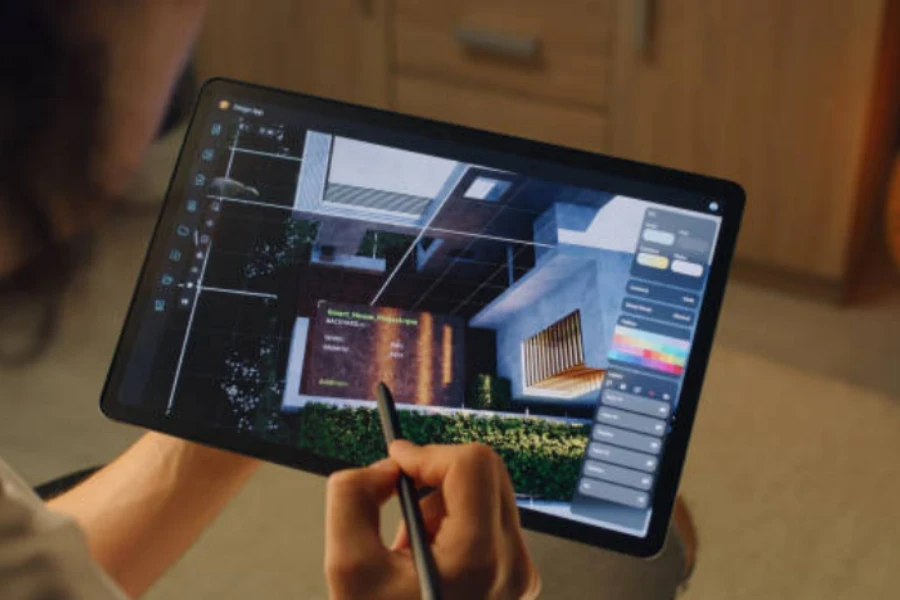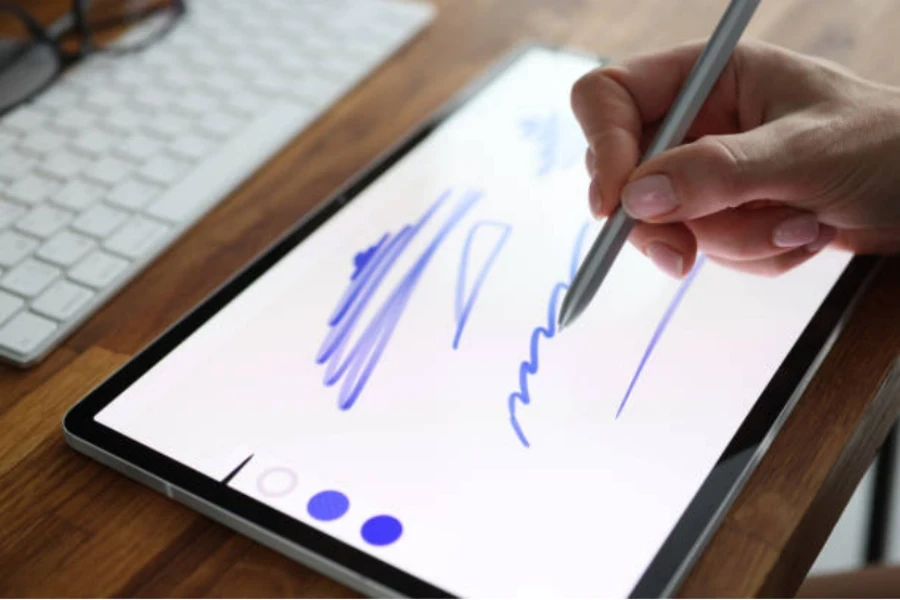In the swiftly advancing world of digital tools, the stylus pen stands out in 2024 as a beacon of innovation and functionality. No longer just a simple accessory, these pens have evolved into sophisticated instruments, integral to enhancing productivity and creativity in various professional settings. From graphic designers sketching intricate layouts to executives annotating critical documents, the stylus pen has become a vital tool, offering precision, ease, and a seamless interface with a range of digital devices. Its significance in the modern professional toolkit is undeniable, marking a new era where the fusion of technology and tactile interaction opens up endless possibilities for efficiency and artistic expression.
Table of Contents:
1. Stylus pen insights: 2024 trends and developments
2. Essentials of stylus pen selection
3. Highlighting 2024’s stylus pen innovations
4. Conclusion
Stylus pen insights: 2024 trends and developments

As 2024 unfolds, the stylus pen market, a subset of the broader digital pen market, is witnessing a remarkable transformation, driven by evolving global dynamics and groundbreaking technological advancements. This section explores these key aspects, offering insights into the current state and future trajectory of stylus pens.
Examining global dynamics
The global dynamics of the stylus pen market are characterized by a notable expansion in market size and a shift in consumer preferences. The demand for stylus pens has surged, fueled by the increasing adoption of tablets and smartphones in various professional sectors. The broader digital pen market, encompassing stylus pens, was valued at USD 3,734.25 million in 2022 and is anticipated to grow to USD 7,674.49 million by 2028, expanding at a CAGR of 12.76%. This growth is not just in numbers but also in the diversity of applications, ranging from digital artistry to business presentations. The evolving preferences reflect a growing appreciation for the nuanced capabilities of stylus pens, such as enhanced precision and improved user experience.
In terms of market trends, there’s a noticeable shift towards stylus pens that offer a blend of high functionality and aesthetic appeal. The demand for stylus pens that mimic the natural feel of writing and drawing, while also providing advanced digital capabilities, is on the rise. This trend is particularly evident in sectors where precision and artistic flair are paramount.
Technological breakthroughs

The realm of stylus pens in 2024 is also marked by significant technological breakthroughs. Innovations are not just limited to the pens themselves but also encompass the broader ecosystem, including software compatibility and integration with various devices.
One of the key technological advancements is the enhancement in pressure sensitivity and precision. This development has been a game-changer, especially for professionals in the creative fields, where the subtlety of pressure can dramatically affect the outcome of their work. Another notable advancement is the improvement in battery life and charging capabilities, making stylus pens more efficient and user-friendly.
Furthermore, the integration of AI and machine learning in stylus pens is opening new frontiers. These technologies are enabling features like improved palm rejection, more accurate handwriting recognition, and even predictive text and drawing capabilities. Such features are transforming the stylus pen from a mere input device into a smart tool that enhances productivity and creativity.
In conclusion, the stylus pen market in 2024 is a vibrant and rapidly evolving landscape. The combination of expanding market size, shifting consumer preferences, and technological innovations is setting the stage for a new era in digital writing and drawing tools.
Essentials of stylus pen selection

In the dynamic world of stylus pens, selecting the right product is crucial for enhancing efficiency and productivity. This section delves into the essential factors to consider when choosing a stylus pen, focusing on compatibility, precision, design, and advanced features.
Compatibility and connectivity
Compatibility is a cornerstone in the selection of stylus pens. The ideal stylus should seamlessly integrate with a wide range of devices, from tablets and smartphones to digital notebooks. This versatility ensures that professionals can switch between devices without hindrance. The connectivity aspect, whether it’s Bluetooth, USB, or proprietary connections, plays a pivotal role in determining the stylus pen’s functionality across different platforms. In an era where cross-device functionality is paramount, a stylus pen that offers broad compatibility and easy connectivity becomes an indispensable tool in the professional toolkit.
Precision and sensitivity
In the realm of stylus pens, precision and pressure sensitivity stand as pivotal features, catering to a spectrum of applications from intricate graphic design to precise note-taking. The precision of a stylus pen is a cornerstone for digital artists and professionals, where the accuracy of strokes and lines directly influences the quality of digital creations. For instance, a high-precision stylus can differentiate between the finest lines, essential for detailed artwork or architectural designs.
Pressure sensitivity elevates the user experience, offering a dynamic range of line thickness and opacity based on the pressure applied, akin to traditional drawing tools. This feature is indispensable for artists and designers, as it allows for nuanced shading and texturing, crucial for lifelike digital art. The sensitivity levels of a stylus can vary, with some offering over 8000 levels of pressure sensitivity, enabling an incredibly detailed and natural drawing experience.
Moreover, the type of stylus pen plays a significant role in determining its precision and sensitivity. While basic passive stylus pens provide fundamental functionality suitable for general use, advanced active stylus pens offer heightened precision and sensitivity, making them a preferred choice for professional applications. These advanced pens are particularly beneficial in fields requiring meticulous detail, such as graphic design, digital illustration, and technical drafting.
Design and comfort
Ergonomic design is another critical factor in the selection of stylus pens. A well-designed stylus pen not only enhances the user’s comfort during prolonged use but also improves overall efficiency. Features such as a comfortable grip, balanced weight, and a design that reduces hand fatigue are essential for professionals who rely on stylus pens for extended periods. The design should cater to a natural hand position, reducing the strain on the wrist and fingers, thereby enabling users to work for longer durations without discomfort.
Advanced features

Advanced features in stylus pens, such as palm rejection, tilt recognition, and extended battery life, add layers of functionality and convenience. Palm rejection technology ensures that the device screen does not misinterpret the resting palm as a touch input, allowing for smoother and uninterrupted writing or drawing. Tilt recognition enhances the drawing experience by varying line thickness and shading based on the angle of the pen, much like a traditional pencil. Additionally, long battery life and efficient charging mechanisms are crucial for uninterrupted work, especially for professionals who are constantly on the move.
When selecting a stylus pen, it is essential to consider these key aspects to ensure that the chosen tool meets the specific needs and enhances the workflow of professionals. A stylus pen that scores high on compatibility, precision, ergonomic design, and advanced features can significantly contribute to productivity and creative expression.
Highlighting 2024’s stylus pen innovations
In 2024, the stylus pen market is brimming with innovations, offering a range of products from premium models to cost-effective choices, each catering to specific needs and preferences. This section highlights these innovations, providing insights into the features and functionalities that set these models apart.

Premium models
In the echelons of high-end stylus pens, certain models stand out for their exceptional features and performance. The Apple Pencil (2nd Generation) remains a paragon of precision and responsiveness. Designed exclusively for the latest iPad models, it offers unparalleled pressure sensitivity and tilt recognition, making it a favorite among digital artists and professionals. Its seamless integration with iPadOS allows for intuitive use, from sketching to note-taking. Another notable mention is the Wacom Bamboo Ink Plus, revered for its compatibility with a wide range of Windows devices. It boasts a fine-tip point, offering a natural pen-on-paper feel, and is equipped with Bluetooth connectivity for quick pairing.
Cost-effective choices
The market also caters to those seeking quality without a hefty price tag. The JamJake Palm Rejection Stylus emerges as a budget-friendly alternative, compatible with various iPad models. It offers basic functionalities like palm rejection and precision, suitable for everyday use. Another economical contender is the Adonit Mark, known for its durability and simplicity. It works well with any touchscreen device, making it a versatile option for users not requiring advanced features like pressure sensitivity.
Specialized innovations

2024 also sees stylus pens tailored for specific industries or unique uses. The Logitech Crayon, for instance, is designed with education in mind. It’s durable, easy to use, and compatible with a wide range of Apple devices, making it ideal for classroom settings. For graphic designers, the XP-Pen Deco Pro stands out with its tilt function and high-pressure sensitivity, offering a level of detail necessary for professional artwork. Additionally, there are stylus pens with specialized features like built-in scanners or OLED displays, catering to niche markets and specific professional needs.
Each of these stylus pens brings something unique to the table, whether it’s the high-end precision and integration of the Apple Pencil, the affordability and simplicity of the JamJake, or the specialized features of the Logitech Crayon and XP-Pen Deco Pro. As the market continues to evolve, these innovations reflect the diverse needs and preferences of users across various sectors.
List of 2024’s top picks
1. Apple Pencil (Second Generation)
Precision: 10.0
Artwork: 10.0
Durability and Features:
Nib: Pencil tip
Compatibility: iPad Pro 11″/12.9″, iPad Air, iPad Mini (generation dependent)
Key Features: Precise with no lag, sensitive to pressure and tilt, excellent palm rejection, wireless magnetic charging.
User Experience: Offers a smooth, lag-free drawing and writing experience with high precision. The rigid nib allows for accurate placement of lines and shapes. However, it is limited to newer iPad versions and is relatively expensive.

2. JamJake Palm Rejection Stylus
Precision: 8.0
Artwork: 8.0
Durability and Features:
Nib: Pencil tip
Compatibility: iPad Pro, iPad, iPad Mini, iPad Air (generation dependent)
Key Features: Precise, palm rejection, amazing price point.
User Experience: Nearly matches the Apple Pencil in functionality but lacks pressure sensitivity. Offers great value for its price, though it requires a charger and is recommended to be used with a glass screen protector for better durability.
3. Mixoo Capacitive Pen
Precision: 3.0
Artwork: 3.0
Durability and Features:
Nib: Disk and mesh
Compatibility: Capacitive touch screens
Key Features: Two nib options, comfortable and accurate, includes three replacement tips.
User Experience: A budget-friendly option for basic navigation and simple tasks. Lacks advanced features like palm rejection, making it less ideal for precise writing or drawing.
4. Adonit Note+
Precision: 9.0
Artwork: 9.0
Durability and Features:
Nib: Flex pencil tip
Compatibility: iPad Pro, iPad, iPad Mini, iPad Air (generation dependent)
Key Features: Flexible tip for comfortable writing, tilt support, consistent palm rejection, pressure-sensitive in some apps.
User Experience: Offers a pen-like feel with a softer nib, providing a comfortable writing experience. However, it requires specific apps to unlock all features and is prone to accidental button presses.

5. Adonit Dash 4
Precision: 8.0
Artwork: 6.0
Durability and Features:
Nib: Flex pencil
Compatibility: All Apple and Android devices
Key Features: Active and passive modes, palm rejection in newer iPads, comfortable and accurate text translation.
User Experience: Versatile for use across multiple devices, offering a comfortable writing experience. However, it lacks tilt and pressure sensitivity, limiting its use for artistic purposes.
6. Samsung Galaxy Tab S6 Lite S Pen
Precision: 7.0
Artwork: 8.0
Durability and Features:
Nib: Fine tip
Compatibility: Samsung Galaxy Tab S6 Lite
Key Features: Smooth nib, palm rejection, accurate, tilt sensitive.
User Experience: Specifically designed for the Samsung Galaxy Tab S6 Lite, it offers a responsive and accurate experience. However, it may experience lag in some apps and is less comfortable for extended use due to its thin design.

Each stylus pen offers unique features catering to different needs. The Apple Pencil stands out for its precision and artwork capabilities but comes at a higher price. Budget-friendly options like the JamJake and Mixoo provide basic functionality without breaking the bank. For those seeking a balance between performance and price, the Adonit Note+ and Dash 4 are excellent choices. The Samsung Galaxy Tab S6 Lite S Pen is ideal for users of specific Samsung devices, offering tailored functionality.
Conclusion
The landscape of stylus pens in 2024 is marked by a blend of innovation, precision, and versatility, catering to a wide spectrum of needs and preferences. From the unparalleled sophistication of premium models like the Apple Pencil to the practical efficiency of cost-effective choices such as the JamJake Palm Rejection Stylus, the sector offers diverse options. Specialized innovations further enrich this field, addressing specific industry requirements. This dynamic array underscores the strategic importance of informed selection, ensuring that each choice aligns with specific operational needs and enhances the overall digital interaction experience.




